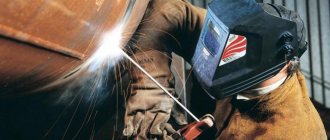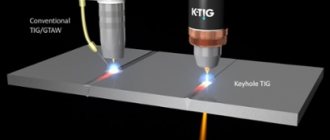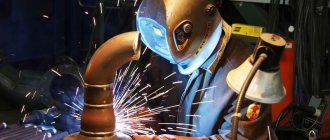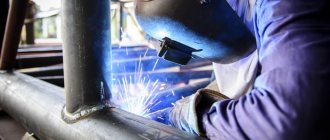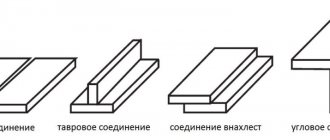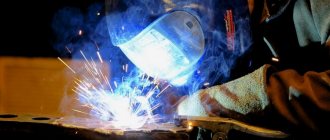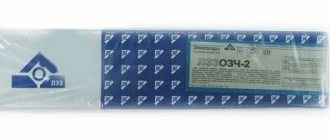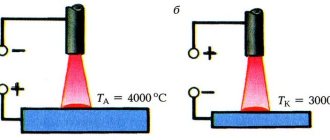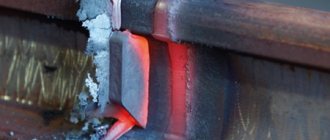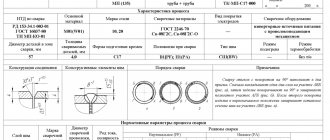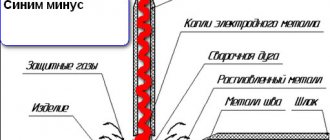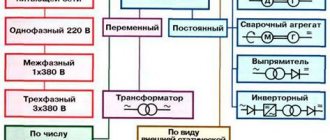Manual electric arc welding is used for welding various types of steel, cast iron and non-ferrous metals. For this purpose, modern devices for manual arc welding are used. They are compact and provide high currents. The weight of low-power household appliances is only a few kilograms. Manual metal welding is used in a variety of areas, both domestic and industrial. To weld two pieces of steel or cast iron together, it is enough to purchase the appropriate equipment.
Welding and equipment with which this process occurs
Welding is the joining of two materials by melting.
Using high temperature, the edges of the materials being joined are melted and mixed together, forming a uniform weld seam. Very often, with the exception of some types of welding, the electrode material is also involved in this process. High temperatures are achieved through an electric arc between the electrode and the material being welded, an electron beam, a laser beam, gas welding and the same methods that cause melting of the metal. Most connections are made to metal parts, but recently welding has begun to be widely used to connect products made of plastic, ceramics, and combinations of these materials.
Naturally, the welding process itself is unsafe. It is necessary to observe special safety precautions so as not to be subject to electric shock, burns to both the cornea of the eyes and various parts of the body, both infrared and ultraviolet radiation, as well as splashes from molten metal.
There are several sources for creating an electric arc and maintaining it. These are transformer sources, inverters, rectifiers. There are also welding units that operate on the principle of an internal combustion engine.
The largest application of these machines is in welding transformers, as well as DC inverter welding machines. If you look at an inverter, it uses high-frequency currents in its operation, while working due to the power electronics built inside, as well as a small-sized transformer - converter. The advantages of this device include its compactness, weight; for domestic use it is quite small, up to 5 kg, as well as energy consumption, which is quite low.
Welding inverter
The disadvantages include the price, which is higher than that of welding transformers, especially professional welding machines with a DC inverter, and special requirements for ambient temperature and humidity. It reacts to voltage drops in the network and its repair is quite expensive compared to the total cost.
If we consider a transformer welding machine, its advantage will be its simplicity of design. The transformer, which is the basis of the device, provides the network voltage to that required for welding. It is powered by alternating current from the network, and we receive either direct or alternating current, depending on the operation scheme of the device. They have a low cost, and if they break down, they are not difficult to repair.
Welding transformer
Devices are divided by power, by the number of workstations connected to one transformer and by voltage, and by network: single-phase or three-phase.
Choke for DC welding machine
Another necessary part of the transformer design is a choke for a DC welding machine, which is used as an amplifier in electrode devices and in semi-automatic machines.
Choke for DC welding machine, diagram.
It is also called an inductor. This part improves the operation of the transformer and is a special wire that is wound around a ferromagnet core. To explain it more simply, the voltage supplied to the output coil increases, and smoothly, the current strength. If you change the polarity, the current decreases, again smoothly, without jumps. This is very important for the uniform burning of the electric arc and, accordingly, for the quality of welding, as well as protection against voltage fluctuations in the network.
The efficiency of the inductor is determined by such a parameter as inductance. It is measured in a value such as Gn. (Henry), which means that through a choke having an inductance of 1 H, at a voltage of 1 V, only 1 A of current can pass through 1 second.
The number of turns on the coil and induction are interrelated according to the principle of direct proportion. Very often, a choke is made by hand, especially since there are enough diagrams on the Internet, as well as descriptions of how to do it. Therefore, it is not necessary to calculate the number of turns or square them.
DC and AC welding machines, what is the difference between them
These welding machines have different welding arcs. Hence the difference in the electrodes used. This should be taken into account when purchasing electrodes. But this is not the only difference; the main difference lies in the design of the welding transformer itself.
AC Welding Machine
As described above, the welding transformer has a core in the form of a closed magnetic circuit under its body, as well as both primary and secondary windings. Electric current passes through the primary winding, magnetizing the core. The resulting magnetic flux on the secondary winding produces alternating current, the voltage of which directly depends on how many turns are wound on the secondary winding. This produces alternating current. If we compare a DC welding transformer, its design contains a rectifier, which makes the current constant.
Transformer circuit
Welding itself with alternating and direct current, when compared, shows that the latter provides a higher quality weld due to the fact that the current value is stable, does not have zero values, and the arc burns constantly. The result is good melting of the edges, while the number of defects in the weld itself is reduced, which improves the quality of the seam. In addition, the spattering of molten metal itself is significantly reduced, which reduces the cost of cleaning the seam after cooling.
Which is the best DC welding machine to buy?
If you consider buying a welding machine, of course, you choose from two categories: for welding at home and for welding in industrial conditions, for professionals. For work in an apartment, house, or garage, household models of step-down transformers are best suited. They can be with several chokes or with one or two rheostats. The main thing in choosing is a single-phase device with 220 V, although there are those that have switching over networks, 220 or 380 volts.
Ammeter for measuring current
The greater the current the device produces, the higher its price, since the greater the thickness of the metal it can weld.
If the goal is to buy a DC welding machine for home use, we can recommend a current value from 50 to 160 A, not higher. When choosing, you need to know basically what kind of work will be carried out and with what metal, how often the equipment will be used and how much money you can spend on the purchase of both the equipment itself and on the required components, and especially personal protective equipment for welding.
Household welding machine
More often used is a machine for manual arc welding with a consumable electrode, which is coated with flux, the so-called MMA welding.
Types of electrodes for manual arc welding.
As an option, non-consumable electrode welding is also used, or is also called: TIG welding, but at home it is not used very often, but this method is suitable for welding thin sheet steel, for example, for car repairs, aluminum parts.
The price for a DC welding machine, for example, Zubr, Fubag, Resanta, Antika - 3300 rubles - 3800 rubles.
If we consider imported equipment, we can suggest the German KRÜGER device, it costs from 5,500 rubles.
Welding machine diagram
Of course, you can make a DC welding machine yourself. This will not be difficult for a specialist if there is access to the materials from which it can be made. Instead of a body, you can use a frame as a basis. You also need a power source that has high power. All instructions can be found on the Internet.
welding equipment
For manual arc welding, it is common to use generators, transformers or rectifiers. The selection of each device is made depending on the type and complexity of welding work. But all equipment for arc welding must meet general standards.
These include:
- the presence of a special device for monitoring current strength;
- ensuring that there are no disturbances in the operation of devices during short circuits;
- the ability to idle while maintaining the arc if the welding circuit is open;
- the device must be endowed with high dynamic capabilities, that is, after a short circuit it must be able to quickly recover;
- good external indicators.
Simpler equipment for manual arc welding, which is suitable for use at home, will differ in a couple of properties. Firstly, complex and simple units will differ in their maximum welding current. And secondly, the working time will be different - during its duration in the cycle this maximum welding current will be generated.
Generators
The welding generator operates with DC characteristics that can provide a stable arc for welding. It consists of a stator with magnetic poles and an armature with collectors and windings. When the armature rotates in the magnetic field created by the stator poles, alternating current begins to appear in the windings, and the collectors convert it to direct current.
In the first case, the movement of the armature is accompanied by an electric motor. It is located with him on the same shaft. This equipment will be called a “welding converter”. In welding machines, the rotating device is the internal combustion engine (internal combustion engine). Their advantages are the ability to connect parts without external sources of electricity.
Rectifiers
A rectifier is a power source that consists of a control device, a rectifier unit and a transformer. Its action is based on the supply of an electric arc with direct current, which flows through the primary winding link and a block of silicon or selenium rectifiers. To obtain a falling external characteristic, the devices are often supplemented with another choke. As a standard, welding rectifiers are manufactured using a three-phase circuit, since it has its advantages in the form of a large number of voltage ripples to ensure a uniform load on the circuit itself.
Transformers
This arc welding equipment is designed to ensure the stability of the electric arc. This means that transformers must have appropriate parameters. According to the standard, this is a falling characteristic, because many transformers are used when argon arc welding or submerged arc welding is needed.
In Russia, industrial current is set at 50 Hz. The transformer ensures the conversion of high voltage to lower voltage until it is suitable for welding. The secondary voltage indicator, taking into account idle speed, is 60-75 V. At low current 65-100 A. In order for the arc to be stable, it is advisable to use a voltage of 75-80 V.
DC or AC inverter - which one to choose
From the moment of its appearance to the present day, welding has firmly held primacy in the processes of joining various parts, products and elements of metal structures. Such a wide range of applications requires a large number of methods and technologies. In order to be able to weld a significant range of metals, various types of welding currents are used.
Types of welding current
Welding transformers output alternating current (AC) at the mains frequency, that is, 50 hertz. Let's be honest: welding metals in this way is a rather problematic process. Firstly, highly qualified welders are required, and secondly, the weld is of insufficient quality.
Changing the arc voltage 100 times per second leads to corresponding changes in the rate of molten metal transfer and the temperature of the weld pool. The result of these processes will be metal spattering and uneven weld penetration. In addition, this type of welding is characterized by the seam moving to the side.
The best results are obtained when welding with direct (DC) current of both direct and reverse polarity (to connect reverse polarity, the “+” and “-” sources are swapped).
Direct current can be obtained from a welding transformer with an additional power rectifier. But, as you understand, this will cause unnecessary expenses. Inverters offer us the best opportunities. Here you can get both AC and DC voltage at the output.
The alternating voltage of welding inverters has a high frequency, due to which the arc parameters become more stable and their characteristics approach those of a direct current arc. Some metals and alloys can only be welded with alternating current, for example, aluminum, which has a very specific oxide film on the surface. This film can only be destroyed by alternating current. Thus, today we have three types of welding current in wide demand:
constant straight polarity;
constant reverse polarity.
DC and AC inverters
Device and difference
Let's look at the operating principle of an AC inverter
. The conversion of mains voltage into welding voltage occurs in the following sequence. First, it is rectified and fed to a converter, which generates a high-frequency pulse sequence. The main idea is to supply a 220 volt network voltage to the step-down transformer with a frequency of not 50 Hz, but 30 - 70 kHz.
In this case, the dimensions and weight of the transformer are significantly reduced. To help you imagine this colossal difference, let's give an example: a transformer with a power of about 5000 W, converting a voltage with a frequency of 50 Hz, will weigh about 20 kilograms. A transformer of the same power, but operating at a frequency of 50 kHz, will weigh 250 grams. What will you choose?
Next, the voltage reduced to 60 volts is supplied to the welding electrode from the output of the transformer.
DC inverter
for the most part repeats the circuit of an AC inverter. But a rectifier is added at the output, which converts the output AC voltage to DC.
What to choose
We have dealt with the differences in the design of these types of power sources for welding processes. But, by and large, for most users the power supply device is of little interest. More important for him is the purpose of the various sources and their areas of application. This will ultimately be decisive in your choice.
Try to choose a welding power source that can be connected to the existing network without the risk of overloading it. In addition, the purpose of the source must correspond to the work that you intend to perform with its help. To make the right choice, familiarize yourself with the features of welding various metals.
Is there a difference between AC and DC welding?
Welding metals with direct current obtained from inverter converters allows even unskilled welders to obtain a high-quality weld. The absence of changes in direction and current strength, characteristic of alternating voltage, ensures smooth and stable arc burning, which leads to an increase in the depth of metal penetration and creates conditions for increasing the mechanical strength of the welded joint.
Another significant advantage
DC welding - reduction of metal spattering, which saves electrodes, filler materials and increases labor productivity by reducing the amount of work required to clean up seams.
Inverter converters are included in various devices as power sources. Manual arc welding machines do an excellent job of welding steel and cast iron parts. For welding stainless steels and non-ferrous metals, it is better to use argon-arc welding machines. A car body is usually repaired by spot welding using the same DC inverter.
Reverse voltage polarity has its advantages and disadvantages
, in comparison with welding with constant voltage of straight polarity. To implement this method, special electrodes or wire are required (in the case of semi-automatic operation). The decision to use one polarity or another depends on the characteristics of the process and the type of welding equipment.
AC welding is used to join refractory metals. In modern practice, this type is used for welding parts with a contaminated surface. It sometimes happens that it is either impossible or very difficult to clean a part. This method works well with oxide films on the surface of metals, even aluminum. In large-scale production, alternating current welding is used as a way to reduce the cost of work on products that do not require special weld precision.
We draw conclusions: each type has a place in production, but the most universal and suitable for the home, garage, and cottage is welding of products with direct current obtained from welding inverters. To confirm the validity of our conclusions, we can cite statistical data indicating that 95.9% of welding machines purchased in Moscow last year were devices based on DC inverters. You can purchase DC inverter devices from the KEDR manufacturer on the official website:
Source
Flaws
Despite the advantages, there are a number of disadvantages:
- Does not cope well with complex types of welding;
- Does not provide a sufficient level of protection, as happens with gas welding;
- The welding speed may be too high;
- High energy consumption during operation.
Types of equipment for manual arc welding
Equipment for manual argon arc welding with a non-consumable electrode and ordinary arc welding are in many ways similar. The main type of equipment is a welding machine. It can be of several types. The simplest is a welding transformer. It has rough performance tuning and is not as economical as its more modern counterpart. But it can withstand longer loads, and is also easy to operate and repair. For modern activities, transformers have a major serious disadvantage. Their dimensions are too large, so they are used mainly permanently in various enterprises.
Welding transformer
A more modern and frequently used welding inverter. This is a compact device that, in addition to the smaller transformer, also contains a lot of electronics. This is one of the main differences between this variety. The inverter cannot operate for a long time, although some professional models can compete with transformers in this parameter. Inverters can have a number of additional functions that simplify the work of the welder. However, they are sensitive to shock, dust and moisture, they are more difficult to repair and the cost of such equipment is much higher.
Difference between AC and DC welding
If you have worked with welding before or are at least somewhat familiar with it, then you have most likely heard the terms “AC” and “DC”. AC and DC are different types of currents that are used in the welding process. Because welding uses an electric arc to create the heat necessary to melt the metal, it requires a stable current with varying polarities depending on the material being welded.
What is polarity?
You are most likely familiar with the term polarity.
Electrical circuits have poles - negative and positive. In a direct current (DC) circuit, electrons move in one direction from plus to minus. When applied to welding, the negative pole receives less heat load.
Alternating current (AC), as the name suggests, changes in the direction in which it flows. Half the time he walks in one direction, and the other half in the opposite direction. Alternating current changes its polarity approximately 120 times per second at a current of 60 Hz.
Direct polarity when welding with direct current gives deeper metal penetration. And reverse polarity is excellent for welding thin-sheet workpieces due to lower heat input.
Coated electrodes can sometimes use either polarity, while some will only work on one.
A high-quality weld requires proper penetration and uniform deposition of the bead, and for this it is necessary to use the correct polarity. With the wrong polarity, you not only get poor fusion and uneven bead formation, but also excessive spatter and overheating, and in some cases you can even lose control of the arc.
The electrode can also burn out quickly.
Most arc welders have marked terminals or directions so that welders know exactly how to set the welder for AC or DC current. Some welders also use switches to change the polarity, and some require the cable terminals to be reconnected.
Manual arc welding
Welding work is the most difficult type of impact on a metal surface. The process requires the professionalism of a craftsman and accuracy, like a jeweler. In order to ensure comfortable work with equipment that is convenient and easy to use, our online store offers a wide range of machines for manual arc welding. Each product is made of high quality materials, has supporting documents and a guarantee.
Features of the welding process
As a result of using a manual arc welding machine, an arc is ignited. This is achieved by touching the electrodes to the metal surface of the workpiece. To achieve a positive result, it is necessary to maintain the arc length during welding and move the electrodes. A short circuit current flows at the site of exposure, which provokes heating of the electrode to the maximum temperature. Next, the arc is ignited and welding occurs with material transfer. To protect the surface from negative factors, many devices use a special gas (argon welding).
Manual arc welding is of the following types:
- one-, two-, multi-electrode, which is used to speed up work and increase labor productivity;
- welding work with direct and alternating current;
- single-phase or three-phase arc welding.
Inverter machines have a number of advantages, including low weight and the ability to obtain an even seam. The device allows you to achieve excellent results, as it is suitable for professional welding. The key difference between the designs is the supply of current, which does not come from the network, but through developed control circuits. In addition to inverter devices, the VELD online store sells semi-automatic devices, argon-arc devices and other useful products.
Advantages of VELD products in Samara
Welding inverters are used by many craftsmen, as they have many advantages, namely:
- High efficiency - the efficiency of the device can reach 95%, while inductive losses are completely absent. The device is equipped with a high-frequency pulse converter, which can effectively reduce the voltage and automatically turn off when there is a break in operation.
- Uninterrupted operation even with voltage fluctuations in the network - the converter allows you to automatically adjust to the input voltage without affecting the output parameters.
- Possibility of using any electrodes - the welder can use direct and alternating current electrodes for cast iron products and structures made of non-ferrous metals.
- Precise manual control of welding current.
- Quick and easy ignition.
- Mobility, light weight, ease of use.
In the WELD store, the client will be able to buy a welding machine with any necessary characteristics. We cooperate with trusted suppliers, including brand companies Resanta, Svarog, Aurora, Torus, IZH, Triton, Telwin, TCC, WEGA, START. The buyer can be confident in the quality of the product, its reliability and efficiency. Our specialists promptly fulfill orders, organize delivery in the city of Samara and other regions of Russia, and inform customers in detail about the selected product. Our advantages are affordable prices, responsive staff, and high professionalism. Hurry up to purchase universal, productive, multifunctional welding machines in our store.
Welding with different currents
Different types of welds require different types of currents due to the nature of their occurrence and the effect they have.
AC Welding
AC welding is considered inferior to DC welding and is therefore rarely used. AC welding machines are most often used only in the absence of DC machines.
AC welding is most often used for joining heavy plates, fast surfacing and high frequency TIG welding, although it is also sometimes used to correct problems with the welding arc. Problems with the arc occur when it interrupts a weld that needs to be welded at higher current levels, which occurs primarily with large diameter electrodes.
AC welding can also be used on magnetized metals, which is not possible with DC welding. The constant change in current direction in AC welding means that the magnetized metal will not affect the electric arc.
AC current is also better when dealing with high temperatures. Since it provides a high level of current, which creates deep penetration, and therefore is used for welding in the construction of ships.
AC welding is well suited for repairing equipment since many of them have magnetized fields and areas that have rusted.
However, directional instability in AC welding can also be a disadvantage in that the process has lower productivity than DC welding.
Pros and cons of manual welding
The cost of welding equipment depends on its parameters. Manual welding has the following advantages:
- It allows you to weld parts in any position in space.
- Manual arc welding can be used to work in hard-to-reach places.
- The ability to quickly move between connected elements.
- This type of welding can be used when working with a wide variety of alloys.
- Ease of use and mobility of manual welding equipment.
The disadvantages include:
- harmful fumes that are generated during welding activities;
- the need for skills and experience, otherwise the quality of the seams will leave much to be desired;
- low efficiency and lower productivity compared to other welding technologies.
DC welding
DC welding, like AC welding, has its advantages, and is used in cases where AC welding cannot provide the desired result, for example, vertical welding, single solder soldering or TIG welding of stainless steel.
DC welding has a higher deposition rate and is best suited for welders who require larger deposit sizes. Although AC welding provides better penetration, it has a lower deposition rate which may not be suitable.
DC welding also produces less spatter than AC welding, resulting in a more uniform and smooth weld. Direct current is also more reliable and therefore easier to work with as the arc remains stable.
DC welding is often used to weld thin metals. Equipment that operates with this type of current is also cheaper, which helps reduce costs.
However, while the hardware itself is lower in cost, the process of actually using DC is a bit more expensive.
This is because special equipment is needed to convert AC to DC because this is not provided by the electrical network. However, since direct current is better suited for most types of welding processes, this expense is considered necessary.
Although DC welding is better for many metals, it is not recommended when working with aluminum as it requires high intensity heat, which is not possible with DC. In addition, if a magnetic field is created when operating with direct current, the risk of arcing will increase, which can be dangerous.
Arc Welding Equipment
The main equipment for manual electric arc welding is welding machines (welding current sources), welding electrodes, electrode holders and welding cables, as well as a protective shield with a light filter. In addition, you will need protective clothing, asbestos sheets, as well as the necessary plumbing tools.
Small-scale welding work can be conveniently carried out on a welding table about 0.6 m high, made of sheet steel.
Welding power sources
Current sources for electric welding are divided into two large groups according to the type of current received from them: alternating current sources and direct current sources.
The first include welding transformers and resonant welding current sources. The second includes welding rectifiers and welding generators.
The most important properties of both the welding arc and welding current sources are described by their current-voltage characteristics (volt-ampere characteristics), which show the relationship between the steady-state values of current and arc voltage and can be falling, hard and increasing (Fig. 17, a
). The current-voltage characteristic has three regions.
Rice. 17.
Current-voltage characteristics of the arc welding process:
A
– static characteristic of the welding arc (I – section of decreasing characteristic; II – section of hard characteristic; III – section of increasing characteristic;
1, 2, 3
– sections of characteristic for different welding methods);
CVC of welding arc power sources ( b
– falling;
c
– hard;
d
– increasing);
d
– combined current-voltage characteristics of the power source and the welding arc (voltage-voltage characteristic of the power source; voltage-voltage characteristic of the arc; Ux.x. – no-load voltage; Isk – short-circuit current)
The first region (I) is characterized by a sharp drop in arc voltage Ud with an increase in welding current Iw. This characteristic is called falling and is caused by the fact that as the welding current increases, the area and, consequently, the electrical conductivity of the arc column increases.
In the second region (II) of the characteristic, an increase in the welding current does not cause a change in the arc voltage. The characteristic of the arc in this area is called rigid. Its position in this area occurs due to an increase in the cross-section of the arc column, anode and cathode spots in proportion to the magnitude of the welding current. In this case, the current density and voltage drop throughout the entire section do not depend on changes in current and remain almost constant.
In the third region (III), with increasing welding current, the arc voltage increases. This characteristic is called increasing. When operating at this characteristic, the current density at the electrode increases without increasing the cathode spot, while the resistance of the arc column increases and the arc voltage increases.
Stable burning of a welding arc is possible only if its power source maintains a constant required voltage when current flows through the welding circuit.
For stable burning of the welding arc, there must be equality between the voltages and currents of the arc (Ud and Id) and the power source (Uip and Iip). Sections 1, 2, 3 characteristics (Fig. 17, a
) correspond to the static characteristics of power sources (Fig. 17,
b – d
) used in various welding methods:
● 1 (falling) – manual arc welding with stick electrodes;
● 2 (hard) – automatic, semi-automatic submerged arc welding, electroslag welding with thick electrode wire with a diameter of more than 2.5 mm at low and medium current densities;
● 3 (increasing) – submerged arc and gas shielded welding with thin electrode wire at high current densities.
The operation of the welding circuit and arc must be considered by superimposing the static I-V characteristic of the welding arc on the static I-V characteristic of the power source (also called the external characteristic of the power source). In this case, the voltage and current of the power source and arc coincide at points 1 and 2 (Fig. 17, d
). Only point 1 corresponds to a stable burning of the welding arc.
When the arc current decreases, the source voltage will become greater than the voltage on the arc, since the operating point on the power source characteristic will shift to the left, the excess voltage of the power source will lead to an increase in the arc current, i.e., to the return of the process to point 1. If the arc current increases, then the source voltage will decrease according to the external characteristic of the power source and become less than the arc voltage, the arc current will decrease, and the arc mode will be restored.
Point 2 corresponds to an unstable arc, since a random change in the arc current occurs until the arc breaks or until the current reaches a value corresponding to the current value at point 1 of a stable arc. Therefore, stable arc burning is maintained only at the point of intersection of the characteristics of the source and the arc, where the external characteristic of the power source is steeper than the static characteristic of the arc.
Manual electric welding is usually accompanied by significant fluctuations in arc length. In this case, the arc should burn steadily, and the arc current should not change much. It is often necessary to increase the length of the arc, so the arc must have a sufficient supply of elasticity when extended, i.e., not break.
The static characteristic of the welding arc in manual welding is usually rigid, and the deviation of the current when changing the arc length depends only on the type of external characteristic of the power source. All other things being equal, the greater the slope of the external characteristic of the power source, the higher the elasticity of the arc, and the smaller the deviation of the arc current. Therefore, for manual electric welding, power sources with falling external characteristics are used. This allows the welder to lengthen the arc without fear of breaking it, or reduce the length of the arc without excessively increasing the current.
High arc stability and elasticity, stable welding mode, reliable initial and re-ignition of the arc are also ensured by increased no-load voltage and limited short-circuit current. Limiting this current is very important, since when a drop of molten metal from the electrode passes onto the product, a short circuit is possible. At high values of short circuit current, metal burns, sticking of the electrode, shedding of the electrode coating and splashing of molten metal occur. Typically, the value of the short circuit current is 1.2–1.5 times greater than the arc current.
The main data on the technical characteristics of welding arc power sources are open circuit voltage[9], rated welding current[10], and welding current control limits.
The values of current and voltage on the arc continuously change during the welding process. Drops of molten metal close the arc gap, periodically changing the current strength and arc length. There is a transition from idle to short circuit, then to arcing with the formation of a drop of molten metal, which again closes the arc gap. In this case, the current increases to the value of the short circuit current, which leads to compression and burnout of the bridge between the drop and the electrode. The voltage increases, the arc is re-ignited, and the process is repeated periodically.
Such changes in current and voltage on the arc occur in a fraction of a second, so the power source of the welding arc must have high dynamic properties, i.e. quickly respond to all changes in the arc.
Types of welding machines
Welding equipment comes in several types: generators (units), transformers, semi-automatic machines, welding rectifiers, inverters. Each of these devices has pros and cons.
Welding generators are complex electromechanical devices that themselves generate electricity and therefore can be used in non-electrified objects: in a house under construction, a garage, or on a newly purchased summer cottage. Their main disadvantage is their large size, enormous weight and labor-intensive maintenance. In addition, they are very expensive.
AC welding transformers are perhaps the simplest, least expensive and most common of all types of welding machines. Like most other household welding machines, they use consumable electrodes.
Such welding machines are usually used for welding low-alloy steels. A high-quality transformer is extremely reliable and does not require special maintenance. But AC welding is of low quality and requires certain skills from the welder. Adjusting the current strength is quite inconvenient - it is carried out by moving the dissipation core, tapping the windings on the primary side, or using a magnetic amplifier (transductor)[11].
This, in turn, increases and makes the welding transformers heavier, which already have considerable dimensions and weight.
You can indirectly judge the current-voltage characteristics of a welding machine using the passport data. Namely, knowing the no-load and rated voltages, as well as the rated (operating) current and short-circuit current, you can fairly accurately estimate its steepness. If the parameters are unsatisfactory, the slope of the current-voltage characteristic can be increased by including a ballast resistance in the welding circuit, but it is still better if the device does not need it.
Welding rectifiers are the same alternating current transformers, equipped with a rectifier unit and sometimes a control device. A more complex device consumes more electricity and is much heavier. But direct current provides better and more comfortable work. The advantages of welding rectifiers are, in addition, the ability to weld not only ferrous, but also non-ferrous metals and alloys, as well as lower cost compared to more complex devices.
Sometimes the current received at the output of the rectifier has too high a ripple factor and does not support the arc well at direct current. Then a smoothing choke is also used, and its weight can be comparable to a transformer (the heaviest part).
Semi-automatic welding machines are also made on the basis of transformers. Their peculiarity is that welding is carried out not with electrodes, but with a special wire in a gas environment (usually argon or carbon dioxide is used). There are models that allow you to work without gas, for which a special flux-cored wire is used. Such devices allow you to cook steel, including stainless steel, as well as aluminum. The metal being welded determines the material of the wire and the gas used: carbon dioxide is best for iron, argon is best for aluminum.
The welding wire is automatically fed through the hose into the welding torch, providing an even, well-protected seam from corrosion. This type of welding is widely used in car repair. The disadvantages of semi-automatic machines can be considered large weight and dimensions, high price and complex design, including a roller wire feed mechanism. In addition, welding requires a gas cylinder. The nominal service life of semi-automatic welding machines is 5 years with a change of welding torch every six months.
Welding inverters are perhaps the most popular category of welding machines today. The operating principle of the inverter is as follows: alternating current from the consumer network with a frequency of 50 Hz is rectified and smoothed by a filter. The resulting direct current is converted by the inverter back into alternating current, but at a high frequency (up to 100 kHz). Then the high frequency alternating voltage is reduced to 70–90 V, and the current is correspondingly increased to 100–200 A required for welding. The high frequency of the welding current makes it possible to achieve significant advantages of the welding inverter over other welding arc power sources: small dimensions and weight, high Power supply efficiency (about 90%). The arc in this case turns out to be very stable, the weld comes out much smoother than with transformer-type models.
Modern inverters, along with direct current, also produce alternating current, both in sinusoidal and rectangular pulses. Electrodes, for example, with an exclusively basic coating, which do not allow welding with sinusoidal alternating current, are successfully melted when applying square-wave alternating current. Such a need may arise in the presence of unfavorable blast conditions.
Electronic control of the inverter allows you to adjust the parameters of the welding current in microseconds, limit the short circuit current and improve cos ϕ. If, for example, the arc voltage due to a large drop formed on the electrode becomes too short and falls below 8 V, the current is automatically increased. This can help the electrical arc be released and not go out. This function is especially important when welding with electrodes with cellulose, as well as with a base coating.
Simple welding transformers are connected to a one- or two-phase consumer electrical network, more powerful devices are connected three-phase to all three phases of a three-phase current network. In the latter case, you can get a very uniform current without large ripple. Current uniformity is especially important when welding with basic electrodes and welding metal alloys such as nickel.
The width of the electric arc, and therefore its rigidity, can be smoothly changed using an adjustable throttle. A more rigid arc is required, for example, in the presence of unfavorable blast conditions.
The “Hotstart” function ensures reliable ignition of the arc and sufficient heating on the still cold base material at the beginning of welding. In this case, ignition is performed with increased current strength.
The Antistick function prevents the electrode from calcining when ignition fails and the electrode sticks to the product. If there is no voltage increase after ignition, the current immediately drops to a few amperes. After this, the electrode can be easily separated from the metal.
Inverters also have disadvantages: first of all, the high cost compared to other types of welding machines, as well as the demands on the quality of power supply - during voltage surges or sags, which in our reality happens quite often, the inverter can quickly fail. These devices are sensitive to dust, so manufacturers recommend cleaning the inside of the device at least twice a year. Inverters do not like frost, and at temperatures below –15 °C their operation is not always possible. The maintainability of such equipment is very low - the complex electronic circuit is inaccessible to a non-specialist, setting it up requires special measuring equipment, and the cost of repairs in a workshop will be at least a third of the price of the entire device. Inexpensive inverters from Asian countries especially suffer from this behavior. More reliable devices from reputable brands are significantly more expensive. And one more feature: the length of each inverter welding cable should not exceed 2.5 meters.
When choosing a particular device, the following considerations should also be taken into account.
All welding machines have such a characteristic as PV - duration of switching on, or PN - percentage of continuous operation time at a certain current. This is an indicator of the continuous arc burning time that a specific model of welding equipment can provide during a conventional 10-minute cycle. For example, the passport indicates that for a current of 160 A, PV = 30%. This means that the device will work for 3 minutes (10 minutes x 30%), and you will have to take a break for 7 minutes. Therefore, you should not buy a device with a rated current of 120 A and a duty cycle of 20%, which will overheat through one or two electrodes. In addition, many manufacturers lower the measurement conditions, for example, lowering the ambient temperature or taking a five-minute interval. As a result, the device either does not provide the required current, or operates with overload, overheats and fails. It is always necessary to have a reserve of current (power), so the optimal parameters of the device for most household work are 160 A and a duty cycle of at least 40%. If you need to work for a long time, you need to purchase a welding machine with an even higher duty cycle.
Most models of welding machines operate at a voltage within 220 V ± 10%, i.e. from 198 to 242 V. Some models operate stably with a voltage drop of up to 20% (176 V). This is of great importance for areas with low network voltage. In addition, you should clarify the power supply in the area where you will work: single-phase (220 V) or three-phase (380 V).
In the private sector, neighbors whose electricity supply is most often carried out in different phases can cooperate and purchase a three-phase welding source. In this case, the payment for electricity and the load on the network will be distributed equally, the quality of welding will increase, and there is no need to specially connect a three-phase power supply (which is very troublesome and expensive).
Depending on the type and thickness of the metal that will have to be worked with, the type and power of the welding machine (and, accordingly, its cost) are determined. If you have to work at heights and constantly move the welding machine, it is best to purchase compact, portable models: they can be used in an apartment, in a country house, or in a garage. If all this is not important, it is better to choose a device with more features.
Electrodes for arc welding
For manual arc welding of steels, consumable metal electrodes in the form of rods up to 450 mm long made of welding wire with a coating layer applied to them are widely used. One of the ends of the electrode is 20–30 mm free from the coating in order to clamp it in the electrode holder with reliable electrical contact. The end of the other end is cleared of coating to allow the arc to be excited by touching the workpiece at the beginning of the welding process.
The electrode coating includes the following components:
● gas-forming substances – inorganic substances (marble CaCO3, magnesite MgCO3) and organic substances (starch, dextrin);
● ionizing or stabilizing – various compounds, which include potassium, sodium, calcium (chalk, feldspar, granite, etc.);
● slag-forming materials that form the basis of the coating - usually ores (manganese, titanium), minerals (ilmenite and rutile concentrates, feldspar, silica, granite, fluorspar, etc.);
● alloying elements and deoxidizing elements – silicon, manganese, titanium, etc., used in the form of alloys of these elements with iron, so-called ferroalloys;
● binding components – aqueous solutions of sodium and potassium silicates, called liquid glass.
To increase welding productivity, iron powder is added to coatings up to 60% of the coating mass.
Based on the type of coating, electrodes are distinguished with an acidic coating ( A ), basic ( B ), cellulose ( C ), rutile ( R ) and a mixed type. Electrodes with a mixed type coating have a corresponding double symbol: acid-rutile - AR , rutile-basic - RB , rutile-cellulose - RC . Other types of coating are designated by the letter P. If the coating contains iron powder in an amount of more than 20%, the letter Z .
Acidic coatings (electrodes ANO-2, SM-5, etc.) consist mainly of oxides of iron and manganese (ore), silica, ferromanganese. They are technologically advanced, but the presence of manganese oxides makes them toxic.
Basic coatings based on calcium fluoride and calcium carbonate (electrodes UONII-13/45, OZS-2, DSK-50, etc.) do not contain iron and manganese oxides. Welding with basic coated electrodes is carried out using direct current and reverse polarity. Due to the low tendency of the metal to form crystallization and cold cracks, electrodes with this coating are used for welding large sections.
Rutile coatings (electrodes ANO-3, ANO-4, OZS-3, OZS-4, OZS-6, etc.) contain a predominant amount of rutile TiO2. Such coatings are less harmful than others to the welder’s respiratory organs. For slag and gas protection, appropriate mineral and organic components are introduced into coatings of this type. When welding with direct and alternating current, metal spattering is insignificant. The arc stability and seam formation in all spatial positions are good.
Cellulose coatings (electrodes VSC-1, VSC-2, OZTS-1, etc.) are based on cellulose, flour, organic resins, ferroalloys, talc or other organic compounds that create gas protection for the arc and form a thin slag during melting. These coatings are convenient for welding in any position in space, but produce deposited metal with reduced ductility. Cellulose-coated electrodes are usually used for welding thin steel.
Depending on the thickness of the coating, depending on the ratio of the diameter of the electrode D to the diameter of the steel rod d, electrodes are distinguished:
● with thin coating (D/d≤1.20) – M ;
● with medium coverage (1.20 C ;
● with thick coating (1.45 D ;
● with a particularly thick coating (D/d>1.80) – G.
There are electrodes for welding with alternating and direct current of direct and reverse polarity. Coated electrodes are produced with a metal rod diameter from 1.6 to 12 mm and a length from 150 to 450 mm. The symbol for the type of electrode is deciphered as follows: the letter E is an electrode, the number behind it is the temporary tensile strength of the weld metal (for example, type E46 electrodes of the OZS-4, ANO-3 brands must provide a temporary resistance of at least 451 MPa (46 kgf/ mm2)). The letters and numbers included in the designation of the types of coated electrodes for welding alloy steels show the approximate chemical composition of the deposited metal (E-09X1MF, E-12X13). For each type of coated electrode, one or more grades have been developed, characterized by the grade of welding wire, coating composition, chemical composition and properties of the weld metal, etc.
In addition to consumable coated electrodes for manual arc and mechanized types of welding in shielding gases, non-consumable tungsten, and less commonly, carbon and graphite electrodes are used. These electrodes serve to initiate and maintain the arc. To increase the stability of arc combustion and the durability of tungsten electrodes, 1.5–3% activating additives (thorium dioxide, lanthanum and yttrium oxides) are introduced into them, which increase the emissivity of the electrode.
Tungsten electrodes are produced in the form of rods with a diameter of 0.5; 1.0; 1.6; 2.0; 2.5; 3.0; 4.0; 5.0; 6.0; 8.0 and 10.0 mm. Depending on the chemical composition, electrodes are made of the following grades: EHF - from pure tungsten, EVL - from tungsten with an additive of lanthanum oxide, EVI - from tungsten with an additive of yttrium oxide, EVT - thorium oxide. The numbers in the tungsten electrode brand indicate the amount of activating additive in tenths of a percent. Carbon and graphite electrodes (rods) are made from electrical coal or synthetic graphite with a diameter of 4 to 18 mm and a length of 250 to 700 millimeters.
Symbols of electrodes for manual arc welding. According to GOST 9466–75, the symbol of electrodes for arc welding and surfacing of steels is a long fraction, for example:
The numerator contains the type of electrode E46A, its brand UONII-13/45, diameter 3.0 mm and a group of two letters and numbers UD2. Types of electrodes for manual arc welding of carbon, low-alloy, structural and other steels are designated by the letter E, followed by numbers indicating the strength characteristics of the deposited metal. Thus, the first group (E46) says that electrodes of this type provide a minimum temporary resistance of 460 MPa. In other words, it shows what load the unit can withstand after welding with this electrode, namely 46 kg per 1 mm2.
If the designation contains the letter A after the numbers, it means that this type of electrode provides higher plastic properties of the deposited metal. For welding the above steels, 14 types of electrodes are provided (Table 1)[12], in which the main mechanical properties and the content of harmful impurities (sulfur and phosphorus) are determined.
The first letter of the last group of the numerator (U) indicates the purpose of the electrode (i.e. for welding carbon and low-alloy steels, see below), the second (D) - the thickness of the coating (see above), number (2) - the group of electrodes by quality manufacturing.
Electrode assignment letter code:
U – for welding carbon and low-alloy structural steels with tensile strength σB < 600 MPa (60 kgf/mm2);
L – for welding alloyed structural steels with σB > 600 MPa (60 kgf/mm2);
T – for welding alloyed heat-resistant steels;
B – for welding high-alloy steels with special properties;
N – for surfacing surface layers with special properties.
Based on quality, electrodes are divided into three groups 1, 2 and 3, where the requirements increase from group 1 to group 3.
The denominator contains the letter E (electrode), a group of indices 412(5), indicating the characteristics of the deposited metal and weld metal (according to GOST 9467–75, GOST 10051–75 or GOST 10052–75) and a group of one letter and two numbers (B10 ). The letter B indicates the type of coating, the first number (1) is the permissible spatial positions during welding, the second number (0) is the requirement for the arc power supply.
Permissible spatial positions during welding or surfacing are designated as follows:
1 – for all positions;
2 – for all positions except vertical from top to bottom;
3 – for lower, horizontal on a vertical plane and vertical from bottom to top;
4 – only the lower one and the lower one “in a boat”.
According to the type and polarity of the current used during welding or surfacing, as well as the rated open-circuit voltage of the alternating current source with a frequency of 50 Hz, the electrodes are divided in accordance with Table. 2.
Several brands can correspond to the same type of electrodes, for example: electrodes of type E46 correspond to brands ANO-4, MR-3, etc.; Electrodes of type E42A correspond to grades UONII-13/45 and SM-11 (Table 3).
Such a complete symbol must be indicated on labels or when marking boxes, packs and boxes with electrodes. In all types of documentation, an abbreviated symbol for electrodes is given, which should consist of brand, diameter, group of electrodes and standard designation (GOST 9466–75).
Which electrode should I use?
Since the type of current used affects the polarity at the electrode, the electrode used must be taken into account.
For TIG welding, direct current of straight polarity is often used. Sometimes reverse polarity current or alternating current is also used. In these cases, tungsten electrodes with alloying additives are used to improve arc stability.
- WP - tungsten electrodes for welding with alternating current;
- WL-20 and WL-15 are alloyed tungsten electrodes for welding with direct and alternating currents.
For MMA welding I mainly use coated consumable electrodes.
Currently, manufacturers produce electrodes with four types of coating:
- Sour (labeled “A”). It contains iron and manganese in quite large quantities. You can weld raw metal.
- Basic (marked “B”). These electrodes can be used for AC operation, but due to their low ionization potential, this is not recommended.
- Rutile (marked “P”). Best suited for AC operation. Little metal spatter and good seam quality.
- Cellulose (labeling “C/S”). Suitable for AC and DC operation, but produces a lot of metal spatter.
There are several different types of AC welding electrodes, but many can be used for both AC and DC welding.
Selecting the correct polarity and current, as well as the correct electrode, can be critical to making a good weld.
Source
Purchase of welding equipment for manual welding
Manual welding with an inverter is used in many household, industrial and construction areas. You can purchase equipment for electric arc welding using the ITC SKON catalog. We will delight the buyer with a large selection of inverter devices from Russian and foreign manufacturers at low prices. Check the cost of the equipment on the website or make a request to the support service.
If you have any questions about the product range or cooperation, please call the contact number provided on the website. We will deliver welding machines for manual welding completely free of charge and offer additional accessories - electronic masks, comfortable suits made of durable fabrics, glasses and leggings. All types of electrodes are also available, including welding wire and tungsten electrodes.
How does a DC welding machine work?
For almost the entire last century, welding work was carried out using alternating current, unless gas welding was used. This was due to the fact that simpler and inexpensive welding equipment was not available in industry and construction.
The AC welding machine was a powerful step-down transformer with a current regulator in the form of a movable secondary winding or additional taps in it. These were reliable, simple devices, but very heavy and bulky. But thanks to the development of semiconductor technology, it became possible to create a DC welding machine, which in terms of consumer properties is better than its “changeable” brother.
Advantages and disadvantages
The use of direct current allows you to obtain a better quality seam due to the fact that the electric arc is stable. There are no zero crossings like an AC unit, so no splashing.
The ability to use direct and reverse polarity allows you to weld stainless steel and non-ferrous metals, that is, direct current electric arc welding has a wider range of applications, all other things being equal. When using inverters, the welding machine is significantly smaller in size and weight.
The disadvantages are the relatively high cost (compared to AC devices) and sensitivity to dust. You have to clean the indoor units often.
Manual arc welding technology: advantages and disadvantages
The advantages of manual arc welding are as follows:
- Low cost of equipment and equipment in comparison with other technologies;
- High speed of setup and no need for preparatory work;
- No risks associated with the use of flammable and explosive substances (in particular gases);
- Possibility of working with structures in any spatial position and in the minimum available space;
- Compactness of the inverter apparatus and the necessary support;
- Possibility of connecting an MMA inverter to a household network;
- Wide selection of welding machines with different parameters;
- An impressive range of electrodes with different chemical compositions, allowing you to choose the optimal brand of consumables for a specific task.
But, of course, manual welding technology is not perfect. Otherwise, other types of similar work would not be needed. The disadvantages of using MMA devices include:
- Weak protection of the formed seam from external factors and, as a result, its low strength in comparison with seams made using other welding technologies. Under unfavorable external conditions (strong wind, rain, snow), there is a high probability of marriage;
- The high speed of seam execution requires certain skills and accuracy from the performer;
- The difficulty of joining elements made of non-ferrous metals, stainless steel, high-alloy steels and some other alloys;
- The need for a large amount of flux and other materials that can improve the quality of the seam.
Devices on transformers
The first models of permanent welding machines were a development of alternating current devices.
In addition to the welding transformer, a diode rectifier made according to a bridge circuit was mounted at the output of the secondary winding, then powerful capacitors were connected to reduce ripple and a choke to obtain a more stable arc. From a single-phase or three-phase network, alternating voltage was supplied to the primary winding of the step-down transformer. At the output of the secondary, a voltage of about 70 V was obtained at idle, then it went to the rectifier and welding electrode.
When the electrode was shorted to ground and then separated for a short distance (approximately 5 mm), an electric arc occurred. The welder had to move the electrode along the future seam at the speed necessary to form a weld pool.
Inverters
Welding inverters, which also belong to direct current devices, operate on the same principle.
Transformations in them occur somewhat differently. The input mains voltage of 220 V is immediately converted by the rectifier into direct current. Using a low-pass filter, the ripples are smoothed out, and the current, as a supply, is supplied to the master oscillator, power bipolar or field-effect transistors.
The generator produces a signal with a frequency of 40 to 80 kHz. Changing the frequency with a variable resistor located on the front panel allows you to adjust the strength of the welding current. This frequency is supplied to the control inputs of power transistors, and the output results in a pulsed current of the same frequency.
For further conversion, it is passed through capacitors to produce high-frequency alternating current. It is then fed to a step-down transformer.
A reduced high-frequency voltage is removed from the secondary winding. Thanks to this, such bulky converters (low-frequency step-down transformers) are not required. In this case, the welding station turns out to be compact and ergonomic.
The resulting high-frequency current is rectified again by the diode bridge and turns into direct current. To reduce pulsations, capacitor banks are installed, and a choke is installed to soften the arc. Thanks to the electronic circuit for controlling the strength of the welding current and voltage, there are no power sags and arc instability.
The welding current does not depend on changes in the mains voltage. The seam is of high quality. It is much easier for a welder to work with such a welding machine. The only thing is that when using electric welding, it is necessary to comply with the requirements for filler wire .
Electrodes for welding should be used those that are recommended for this type of metal. The diameter must be selected based on the thickness of the material being welded.
Catalog of manual welding machines
Are you looking for where to buy a manual welding machine in Volzhsky and Volgograd? Take a look at the catalog of ITC SKON LLC and select an inverter that matches the characteristics. The devices on sale differ:
- duration of continuous operation (SC) - shows how long this device can operate within a 10-minute cycle;
- operating current - the minimum is 5-10 A, the maximum is up to 500 A and above;
- permissible diameter of electrodes - most often their diameter varies from 1.6 to 5 mm, although some devices can work with thicker electrodes;
- power – both low-power equipment for manual welding and more powerful units are available for sale;
- type of welding - the catalog contains manual arc welding machines and machines with a manual argon welding function;
- the presence of additional functions and capabilities - support for manual TIG welding, arc force adjustment, etc.;
- supply voltage – a welding inverter for manual arc welding, depending on the power, is powered by alternating current voltage of 220 V or 380 V (three-phase current).
By purchasing welding machines from ITC SCON, you get certified equipment at the lowest prices. It is suitable for both domestic and professional use for work purposes. Our advantages are a large selection of machines for manual welding, free delivery of equipment, welding materials, protective equipment and accessories are always available.
Which electrodes to use
When selecting electrodes for welding parts with direct current, first of all you need to make sure that there are certificates of conformity.
They must be confirmed by relevant organizations such as the Center for Standardization and Metrology with the appropriate licenses. Next, you need to select electrodes taking into account the power of the welding machine, the thickness of the parts being welded and the type of metal. Among the many brands are the following:
- UONI13/45 electrodes are suitable for DC welding of low-carbon and low-alloy steels. They are good for welding pressure vessels, thick-walled parts, and also for welding casting defects;
- UONI 13/55 electrodes are also used to weld low-carbon and low-alloy steels. Used in welding high-pressure vessels and steel structures;
- Electrodes OZS-12 GOST 9467-75 are used to weld critical structures made of low-carbon steel. Welding is carried out in all positions except for the vertical seam;
- OZS-4 can be welded on an oxidized surface with the same steels.
The brands listed above are the most versatile and easy to use. They can be ignited quickly and provide a stable arc maintained by a constant current.
For medium and high alloy steels, special electrodes are used. They have a composition close to the grade of steel being welded.
Before using the electrodes, you must make sure that they are dry and without chipped coating. Correct selection of grade, diameter, and welding current will ensure a high-quality weld. All necessary data is available in the operating instructions for the welding machine and the passport for the electrodes.
Self-production
It makes sense to make a DC welding machine yourself if you have a supply of semiconductor devices with suitable ratings. When using a traditional transformer current conversion circuit, everything will be quite cheap.
If you decide to assemble an inverter device, then buying power transistors will cost a pretty penny; it’s easier to buy a ready-made inverter.
Rectifier
Direct welding current in homemade machines is usually calculated at 160-200 amperes.
For this purpose, B200 rectifier diodes connected via a bridge circuit will be optimal. You just need to take into account that the case is not isolated from the insides of the diode, that is, when voltage is applied to the terminals, the case will also be energized.
Since they get very hot during operation, they are installed on radiators. They must be isolated from each other, the body of the welding equipment and other elements of the circuit.
If you have diode bridge assemblies at your disposal, then this is even better, since the circuit will be easier to assemble. They have a forward current of about 35-50 A. If a more powerful bridge is required, then the assemblies can be paired and placed in parallel.
The reliability of such a connection is less than that of a single diode due to the variation in parameters, but if installed with a reserve, then everything will be great. Their cases are not energized, so they can be installed on one radiator.
